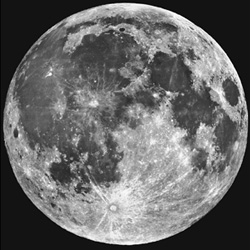
The Moon and its dark spots. Image credit: NASA. Click to enlarge.
People of every culture have been fascinated by the dark “spots” on the Moon, which seem to compose the figure of a rabbit, frogs or the face of a clown. With the Apollo missions, scientists found that these features are actually huge impact basins that were flooded with now-solidified lava. One surprise was that these basins formed relatively late in the history of the early solar system – approximately 700 million years after the formation of the Earth and Moon. Many scientists now believe that these lunar impact basins bear witness to a huge spike in the bombardment rate of the planets – called the late heavy bombardment (LHB). The cause of such an intense bombardment, however, is considered by many to be one of the best-preserved mysteries of solar system history.
In a series of three papers published in this week’s issue of the journal Nature, an international team of planetary scientists, Rodney Gomes (National Observatory of Brazil), Harold Levison (Southwest Research Institute, United States), Alessandro Morbidelli (Observatoire de la C?te d’Azur, France) and Kleomenis Tsiganis (OCA and University of Thessaloniki, Greece) – brought together by a visitor program hosted at the Observatoire de la C?te d’Azur in Nice – proposed a model that not only naturally solves the mystery of the origin of the LHB, but also explains many of the observed characteristics of the outer planetary system.
This new model envisions that the four giant planets, Jupiter, Saturn, Uranus and Neptune, formed in a very compact orbital configuration, which was surrounded by a disk of small objects made of ice and rock (known as “planetesimals”). Numerical simulations by the Nice team shows that some of these planetesimals slowly leaked out of the disk due to the gravitational effects of the planets. The planets scattered these smaller objects throughout the solar system, sometimes outward and sometimes inward.
“As Isaac Newton taught us, for every action there is an equal and opposite reaction,” says Tsiganis. “If a planet throws a planetesimal out of the solar system, the planet moves toward the Sun, just a tiny bit, in compensation. If, on the other hand, the planet scatters the planetesimal inward, the planet jumps slightly farther from the Sun.”
Numerical simulations show that, on average, Jupiter moved inward while the other giant planets moved outward.
Initially, this was a very slow process, taking millions of years for the planets to move a small amount. Then, according to this new model, after 700 million years, the situation suddenly changed. At that time, Saturn migrated through the point where its orbital period was exactly twice that of Jupiter’s. This special orbital configuration caused Jupiter’s and Saturn’s orbits to suddenly become more elliptical.
“This caused the orbits of Uranus and Neptune to go nuts,” says Gomes. “Their orbits became very eccentric and they started to gravitationally scatter off each other – and Saturn too.”
The Nice team argues that this evolution of Uranus’ and Neptune’s orbits caused the LHB on the Moon. Their computer simulations show that these planets very quickly penetrated the planetesimal disk, scattering objects throughout the planetary system. Many of these objects entered the inner solar system where they peppered the Earth and Moon with impacts. In addition, the whole process destabilized the orbits of asteroids, which then would have also contributed to the LHB. Finally, the gravitational effects of the planetesimal disk caused Uranus and Neptune to evolve onto their current orbits.
“It’s very convincing,” says Levison. “We have made several dozen simulations of this process, and statistically the planets ended up on orbits very similar to the ones that we see, with the correct separations, eccentricities and inclinations. So, in addition to the LHB, we can also explain the orbits of the giant planets. No other model has ever accomplished either thing before.”
However, there was one more hurdle to overcome. The solar system currently contains a population of asteroids that follow essentially the same orbit as Jupiter, but lead or trail that planet by an angular distance of roughly 60 degrees. Computer simulations show that these bodies, known as the “Trojan asteroids,” would have been lost as the giant planets’ orbits changed.
“We sat around for months worrying about this problem, which seemed to invalidate our model,” says Morbidelli, “until we realized that if a bird can escape from an open cage, another one can come and nest in it.”
The Nice team found that some of the very objects that were driving the planetary evolution, and which caused the LHB, would also have been captured into Trojan asteroid orbits. In the simulations, the trapped Trojans turned out to reproduce the orbital distribution of the observed Trojans, which was unexplained up to now. The total predicted mass of the trapped objects was also consistent with the observed population.
Taken in total, the Nice team’s new model naturally explains the orbits of the giant planets, the Trojan asteroids and the LHB to unprecedented accuracy. “Our model explains so many things that we believe it must be basically correct,” says Mordibelli. “The structure of the outer solar system shows that the planets probably went through a shake up well after the planet formation process ended.”
Original Source: SWRI News Release

you should have Galileo’s prediction of why theres dark spots on the moon so student can find information about the dark spots more quickly!!!!!!!!!!
sincerly the ,STUDET, & ill be back on this site to see if you do so as in put in Galileo’s thoughts & predictions on the solar system!!